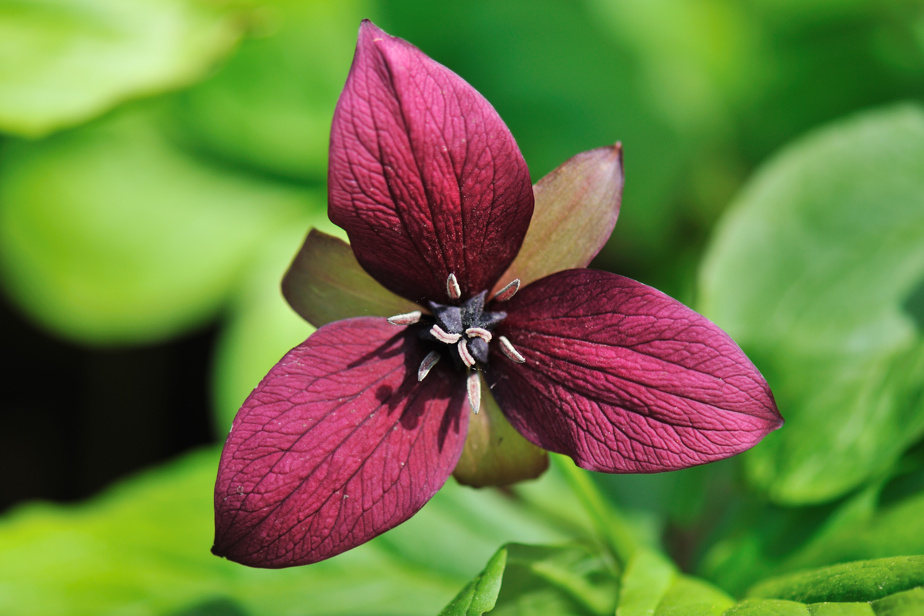Spring is not just the season of mud. It’s also the season for small wild flowers that peek out through the still somewhat gloomy land.
“It’s a very beautiful time of year to be in the forest,” says Joshua Jarry, horticultural information attendant at the Botanical Garden. “If we put on our boots, if we’re ready to brave the mud a little, it’s absolutely magnificent what we’ll find. It’s a forest that comes back to life. »
Obviously, you must avoid fragile, very muddy trails. Many trail managers close their trails for a few weeks in the spring to protect them. You must therefore consult the website or Facebook page of these organizations for information before traveling.
If a path that you thought was reasonably dry turns out to be a little muddier than expected, you must either turn around or accept walking in the middle of the path, in the mud. Above all, you should not walk near the path, which would damage the vegetation and contribute to widening the path.
The ideal is a very stony, well-drained path.
Spring is a season when everything grows so quickly. The landscape changes overnight. Over the last few weeks, we’ve had days where it was very hot, and then lo and behold, we had snow for one or two days.
Joshua Jarry, horticultural information officer at the Botanical Garden
The speed of melting depends on the level of sunlight on the site.
“It will influence the speed at which the flowers will grow,” says Mr. Jarry. This will determine what we see first. »
The type of soil also plays a role.
“Some will become waterlogged, there may be ephemeral ponds. For those who love amphibians, these ponds are truly teeming with life. You can see frogs and salamanders. »
Flowering obviously depends on latitude. In southern Quebec, we mainly see deciduous forests. You have to go further north to have coniferous forests and witness later flowering.

PHOTO KEVIN DERRICK, GETTY IMAGES
The white trillium, a spring classic
One of the earliest spring flowers, and certainly one of the best known, is the white trillium. But you should definitely not pick this beautiful large flower because it will lead to the death of the plant. As its name suggests, the white trillium is white. But we can see a slightly pink version of it. On the other hand, if the trillium is indeed red, it is a red trillium, known for its bad smell.
Many spring flowers are very small or grow close to the ground. Fortunately, as there is still little foliage in the forests, they can be easily observed.
“There is notably the skunk cabbage, which is really at ground level and which prefers soils that are more or less waterlogged,” indicates Joshua Jarry. It is a very early flowerer. At our Botanical Garden, or the First Nations Garden, we have already reached the end of flowering. »

PHOTO ROBERT WINKLER, GETTY IMAGES
Yes, skunk cabbage is a flower.
Obviously, this strange flower doesn’t smell like roses. In fact, with its horns, it doesn’t really look like a flower.
The Canadian bloodroot is also one of the first flowers to appear.
“It is known for its large lobe-shaped leaf,” observes Joshua Jarry. In spring, it really has a beautiful little flower, all white. »
The American Eurasian Ryegrass blooms at about the same time. Its flower is yellow and bends gently towards the ground.
“It’s one of my favorites,” admits Joshua Jarry.
-

PHOTO GILLES MURRAY, PROVIDED BY ESPACE POUR LA VIE
There is nothing sinister about the bloodthirsty of Canada, she is rather pretty.
-

PHOTO MICHEL SOKOLYK, PROVIDED BY ESPACE POUR LA VIE
The small tilted head of the American rythrone
-

PHOTO BRIAN WOOLMAN, GETTY IMAGES
The acute lobe liverwort, in shades of white or pink
-

PHOTO MIRCEAX, GETTY IMAGES
Caroline’s claytony, with its fine pink lines
-

PHOTO GILLES MURRAY, PROVIDED BY ESPACE POUR LA VIE
The hooded dicenter, with its small white horns
-

PHOTO JAMES GABBERT, GETTY IMAGES
The four-stroke. The four white petals are actually leaves that surround tiny flowers.
1/6
The acute-lobed liverwort is also a pretty flower, with various tones of white and pink.
“We also have Carolina claytonia, a white flower, but with beautiful little pink lines inside, really very pretty. »
The hooded dicenter is also a white flower, smaller than the horticultural dicenter found in gardens under the name bleeding heart.
“It looks like it has two little horns, so a very pretty little flower,” says Mr. Jarry.
The four-flower, with its four white leaves surrounding tiny flowers, is another spring classic, as is the little-preacher, which arrives a bit later in spring.

PHOTO MELODY ANNEM, GETTY IMAGES
There does indeed seem to be a little preacher in the little-preacher-ariseme.
“It’s also one of my favorite flowers, a very unique plant in appearance. There is like a little cap that falls over the flower. »
Yes, she does indeed look like a little preacher in her pulpit.
The Wild Flowers of Quebec website allows you to identify flowers by taking into account different elements: color, flowering season, type of habitat and region.
Visit the Wild Flowers of Quebec website
Video suggestion
Kayak trip with dad
A short student film about a somewhat eventful father-son kayaking trip.
Watch the full video
The number of the week
250 meters
This is the height of Cap-Éternité, a unique playground for very experienced climbers.
